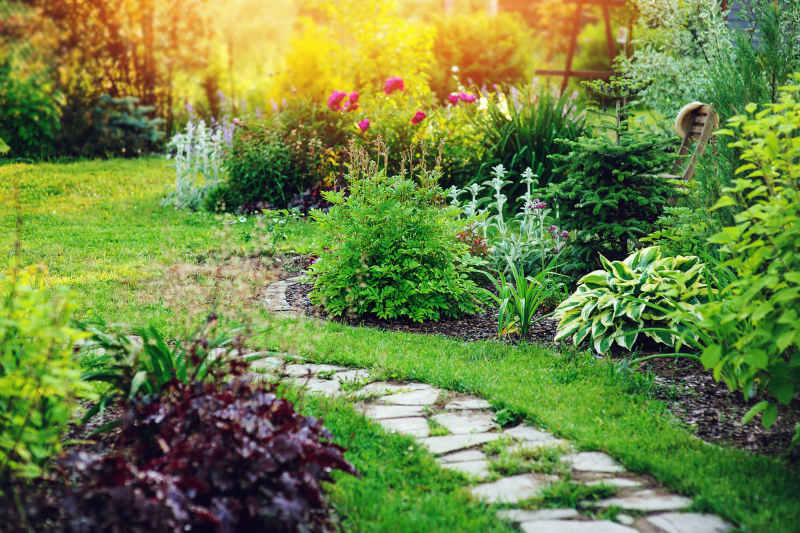What Perennials Should I Divide and Replant in Spring?

Spring is the prime time to divide perennials, particularly the ones that flower in summer and fall.
Through dividing in spring, the new perennial divisions will have a few weeks to root before temperatures rise.
In the Spring, new growth rises above the soil level, on the perennial. And when the leaves are small, it’s less of a challenge to see how and where you can divide the perennial. Waiting risks the leaves, roots and stems on larger, fuller plants.
And if you can’t resist the urge to expand your garden, some of your spring perennial plants may need to be divided in spring simply because they’re too close together.
Or perhaps they’ve crowded out their spot and are brushing up against a fence, tree, sidewalk or other structure. Another plea for separation takes place when plants take on the donut appearance in which all new growth is around th edge of the root ball with a dead center.
A garden spade or sharp-bladed shovel (or a garden fork) is among the best gardening tools you will use. Also, a Pruning saw, serrated bread knife or the like to cut tho the root ball with.
Note: If a plant does the “dividing” for you (by self-sowing new plants), then dig up those seedlings with a trowel. Then replant or give away.
Aster
Divide asters early by late spring, as soon as you notice new growth emerging from the ground.
Use shovel to dig and lift wire root ball. Chop ball into as many slices as you desire with a tree branch clipper, or other serrated saw.
You should aim to have at least one large bunch of leaves in each division. After the last frost date, transplant to a sunny location and water deeply. Aster Divide asters every couple of years.
Black-Eyed Susan
These native perennials can be aggressive, so divide every two years. You should divide when you see new growth in spring.
Dig and lift with a shovel, as with asters. Chop the ball into as many pieces as desired using a tree pruner or other serrated blade and transplant them to a sunny location.
Many types of black-eyed Susan will self-sow, with seedlings that you can transplant.
Chrysanthemum
Simple mum plants are more commonly known as mums, and the best time to divide mums is in spring.
Mums can become overgrown, divide them every two years. As soon as small leaves appear at the bottom of the plant, it’s time to divide.
Dig up the root ball with a shovel or garden fork, using a serrated knife to cut it into as many pieces as you’d like. Be certain that each division has at least one strong set of leaves. Water well and transplant the divisions to a sunny position.
Coneflower
Commonly referred to as purple coneflowers, these native perennials don’t live long, so dividing them every two or three years is the best way to keep fresh new plants blooming in your garden.
Divide in spring when you first see the base of the plant fill in with new growth. Dig around and under the root ball with a shovel or garden fork, and then lift the plant. Cut the root ball into four segments with a serrated blade, ensuring that one set of good leaves accompanies each one. Plant out into a sunny location, water well.
Daisy
This summer bloomer is another short-lived perennial. Daisies should be divided every couple of years to keep them looking good in the garden.
Dig and lift the root ball with a shovel or garden fork. Use a serrated blade to cut the root ball into as many pieces as you’d like, with a strong set of leaves on each. Replant in the sun and water heavily.
Garden Phlox
Divide phlox in the spring when new growth reaches two to three inches.
Lift the root ball with a shovel or garden fork and divide it with a serrated blade; each division should have at least one baby plant. Transplant to a sunny spot with good air movement to avoid fungus disease. Water well. Every three or four years, divide phlox.
Hardy Geranium
Check out our list of the best perennials for the garden One other thing about hardy geraniums, you can divide them in the spring, about every three years. Clip off old growth so you leave new growth at the base of the plant.
Dig and lift the root ball with a garden fork or shovel. Slice with a serrated blade into as many divisions as you desire, one strong growth of leaves per division. Transplant into a sunny or partial shady spot, and water thoroughly.
Final Thoughts
The perennial bulbs you plant, and harvest for next year will provide you with variety, and color all year long, at least it does for me.
It is my yearlong pick, and plant you will love it, and you will be the envy of your neighbors because you colors will be amazing. Make sure to water the replanted bulbs to force the best chance of blooming later.
